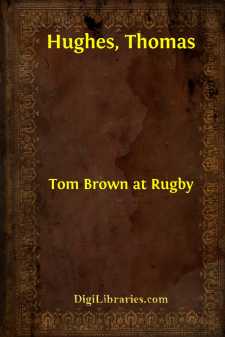Categories
- Antiques & Collectibles 13
- Architecture 36
- Art 48
- Bibles 22
- Biography & Autobiography 813
- Body, Mind & Spirit 142
- Business & Economics 28
- Children's Books 17
- Children's Fiction 14
- Computers 4
- Cooking 94
- Crafts & Hobbies 4
- Drama 346
- Education 46
- Family & Relationships 57
- Fiction 11829
- Games 19
- Gardening 17
- Health & Fitness 34
- History 1377
- House & Home 1
- Humor 147
- Juvenile Fiction 1873
- Juvenile Nonfiction 202
- Language Arts & Disciplines 88
- Law 16
- Literary Collections 686
- Literary Criticism 179
- Mathematics 13
- Medical 41
- Music 40
- Nature 179
- Non-Classifiable 1768
- Performing Arts 7
- Periodicals 1453
- Philosophy 64
- Photography 2
- Poetry 896
- Political Science 203
- Psychology 42
- Reference 154
- Religion 513
- Science 126
- Self-Help 84
- Social Science 81
- Sports & Recreation 34
- Study Aids 3
- Technology & Engineering 59
- Transportation 23
- Travel 463
- True Crime 29
Tom Brown at Oxford
by: Thomas Hughes
Categories:
Description:
Excerpt
A Short Summary, With Some Explanations of Concepts Presented by
Hughes, but Not Well Defined by Him, Being Apparently Well
Understood in His Day, but With Which Modern Readers May be
Unfamiliar.
This is the sequel to Hughes' more successful novel Tom Brown's School Days, which told about Tom at the Rugby School from the age of 11 to 16. Now Tom is at Oxford University for a three year program of study, in which he attends class lectures and does independent reading with a tutor. A student in residence at Oxford is said to be "up" or have "come up", and one who leaves is said to have gone "down".
The author weaves a picture of life at Oxford University in the 1840s, where he himself was at that time, at Oriel College, where he excelled in sports rather than academics. The University is made up of a number of separate colleges, and the students form friendships within and develop a loyalty to their own college. Tom's college, St. Ambrose, is fictional. The study programs available to the students are intended to prepare them for the legal, ecclesiastical, medical and educational professions. Students who do poorly might be expected to enter the diplomatic corps or the army or navy, though a son of the aristocracy might be thrust into a minor church role. To enter into business or manufacturing engineering or the research sciences would require an inheritance or family connection.
Latin was still taught because the best literature available to them was still the ancient Greek and Roman poets and philosophers, and the legal and medical professions still used it extensively, though the ecclesiastical and educational fields had largely abandoned it.
Tom finds that there is a social barrier between the wealthy students and the students that are there on the equivalent of a modern academic scholarship, or have to work as a graduate student tutor to earn their stipend. There were no sports scholarships at this time, though the author hints vaguely at one point that someday the idea could be explored.
There were no female students at this time. Tom becomes involved with a local barmaid. The barmaid being of a different social class than Tom, this relationship causes problems for both of them, and it is important for the modern reader to realize that such social distinctions were very real and inflexible in those days. The working class referred to the educated class as their "betters", meaning better educated and entitled to better respect, regardless of whether it was earned or deserved.
There were no dormitories and self-serve cafeterias as with modern colleges, instead meals were served in a dining hall by scouts, and each student gets what are called "rooms", consisting of a bedroom and a sitting room for study and entertaining. "Scouts" are a kind of servant attached to one student or a small number of students. They run errands, bring meals from the kitchen, and take care of clothing. A bootblack called the "boots" takes care of footwear. A charwoman called the "char" cleaned the rooms.
If a student wished to study without interruption, he would close the oak door to his rooms, which was called "sporting his oak", the signal not to disturb....





